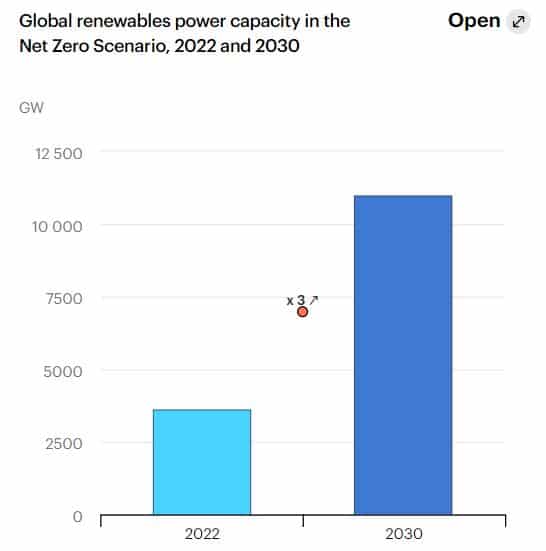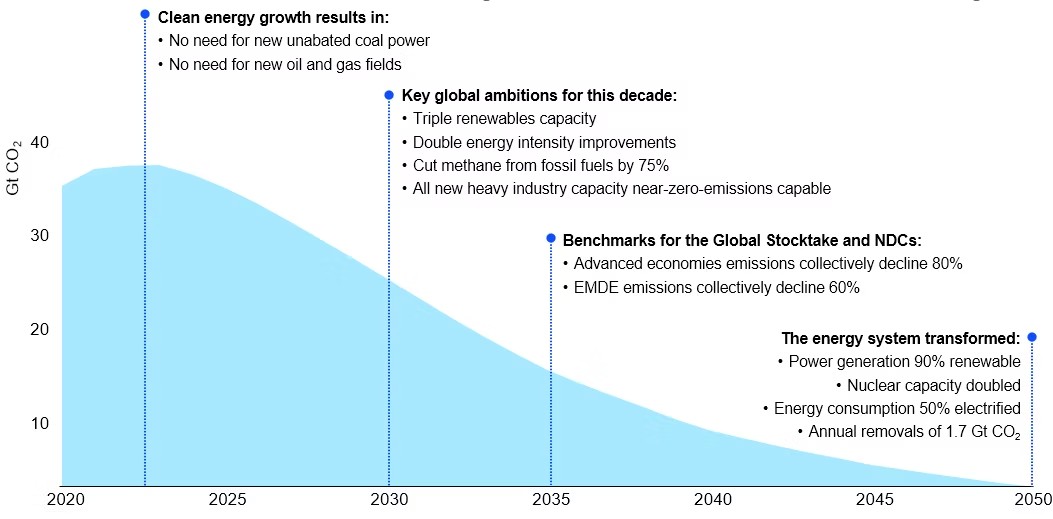The International Energy Agency’s (IEA) latest Net Zero Roadmap suggests that tripling renewables capacity to 11,000 GW by 2030 is one way to reach global climate goals.
The IEA’s 2023 Net Zero Roadmap outlines a global pathway to be on track with the 1.5 ̊C goal. It was first published in 2021, from which the energy sector has seen pivotal shifts.
IEA’s Updated Roadmap to Net Zero by 2050
The updated version also calls for unified efforts to help reduce global warming as world leaders coming together at the upcoming COP28 in Dubai in November.
Ramping Up Renewables Capacity
The agency said that ramping up renewables, alongside improving energy efficiency, reducing methane emissions, and increasing electrification will bring over 80% of emissions reductions needed by 2030.
The roadmap indicates that tripling global installed renewable energy capacity to 11,000 gigawatts by 2030 will achieve the largest emissions reductions.

Under the NZE Scenario, the ramping up of clean energy is the key factor leading to a drop in fossil fuel demand of more than 25% this decade. This, plus supportive policies like repurposing of coal-fired plants are crucial to give more room for clean energy to grow.
Renewable power sources, such as solar PV and wind, are now widely accessible and cost effective. They are also well understood and deployed rapidly. In fact, policy systems have now placed advanced economies, and China, on track to contribute significantly (85%) to this goal.
However, developing economies and emerging markets still need more international support and stronger policies.
For all nations, hastening permitting lead time, modernizing the grids, fixing supply chain issues, and adopting variable renewables are essential.
Earlier this month, the G20 countries heed to support the tripling of renewables. With that, they agreed that a $4 trillion/year needs to accelerate investment in the clean energy transition.
In June, the IEA reported that global additions of renewable power capacity will grow by a third this year. The agency said that it will increase to over 440 GW, the largest growth ever reported. Next year, global renewable electricity capacity is projected to rise to 4,500 GW.
IEA Executive Director Fatih Birol remarked that despite oil price concerns impacting energy security for countries, this year is more optimistic than 2 years ago. He particularly noted that:
“We see legitimate reasons to be hopeful because a new clean energy economy is emerging. While we see the path to 1.5 C narrowing, a spectacular increase in clean techs is keeping the door open.”
Tripling of renewable energy, plus doubling the annual rate of energy intensity improvement are key to ending new coal plants. Energy improvements stem from three crucial measures: improvement in technical efficiency of equipment, more efficient use of energy and materials, and switch to more efficient fuels, particularly electricity.
Electricity is the “New Oil”
Under IEA’s NZE Scenario, rapidly advancing electrification technologies like electric vehicles and heat pumps would be responsible for a fifth of the emissions reductions by 2030.
In particular, EV sales will account for ⅔ of new car sales by the same year. EV production goals from major automakers indicate that achieving such an ambitious goal is possible.
Likewise, heat pumps are also growing globally by 11% last year, with China being still the top market. But others are keeping up such as the EU, which is ahead of the annual growth needed to 2030.
The agency said that as electricity is emerging as the “new oil” of the world’s energy system, funding for power networks must ramp up. This entails ensuring massive growth of battery energy storage and other low-emissions technologies. These include carbon capture, utilization and storage (CCUS), hydrogen, and hydrogen-based fuels, the IEA said.
COP28 Action Plan Shares The Same Goal
Those clean energy technologies, particularly renewables and hydrogen production, are among the major agenda at the upcoming COP28.
COP28 President-Designate Dr. Sultan Al Jaber lays out an action plan heavily focused on fast-tracking the energy transition.
- One key aspect of the plan is to “triple renewable energy capacity, double energy efficiency and double hydrogen production to 180 M tons/year by 2030.”
But with rising oil prices and demand hitting record levels, energy security concerns are also heating up in the lead-up to COP28. The tension gets even higher with the UAE, a major oil nation expanding its production, as the climate summit host.
The energy sector is changing faster than most people expect but much more needs to be done urgently.
The IEA’s 2023 Net Zero Roadmap emphasizes the critical role of renewable energy in achieving global climate goals, alongside energy efficiency improvements, and increased electrification. As world leaders prepare to converge at COP28 in Dubai, the roadmap sets a clear path for addressing climate change and accelerating the transition to a clean energy future.



